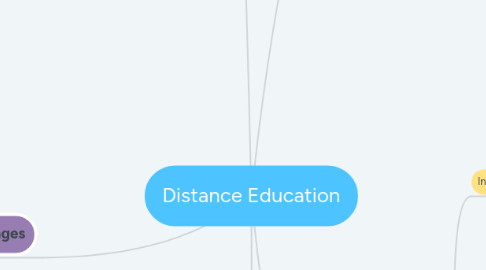
1. Advantages
1.1. Students
1.1.1. Accessible
1.1.2. Flexible Schedule
1.1.3. No location restraints
1.2. University Employees
1.2.1. No location restraints
1.2.2. Flexible work schedules
1.2.3. New jobs
1.2.3.1. Instructional Faculty
1.2.3.2. Technical Support
1.2.3.3. Chief Online Officer
1.3. Generates Revenue
1.3.1. Increasing distance enrollment yearly
1.3.2. Does not require physical space
1.4. Quality Assured through measurement
1.4.1. Course Design
1.4.2. Program Design
1.4.3. Online Faculty Development
1.4.4. Student Outcomes
1.4.5. Accreditation
1.4.5.1. Voluntary
1.4.5.2. Visible to students, faculty, community
1.4.6. Intput Metrics
1.4.6.1. Program Reputation
1.4.6.2. Faculty Training
1.4.6.3. Faculty Credentials
1.4.7. Output Metrics
1.4.7.1. Student Academic Achievement
1.4.7.2. Post-graduation Student Employment
1.4.7.3. Retention/Graduation Rates
1.5. Increasing Continuing Education
1.5.1. MOOCs
1.5.1.1. Unlimited Participation
1.5.1.2. Open Access
1.5.2. Education by Topic of Interest
1.5.2.1. Allows nurses to chosen education in specialties
1.5.2.2. Increased access to undergraduate and graduate schools
1.5.2.3. Staff development courses online rather than through workplace
1.6. Growth
1.6.1. Increased enrollment while traditional enrollment declines
1.6.1.1. Increase in (nursing) workforce
1.6.1.2. Decrease in nursing shortage
1.6.2. Further credentialing students (nurses) to pursue advanced positions
1.6.2.1. Increase in advanced practice providers and educators
2. Disadvantages
2.1. Faculty Perception
2.1.1. Lesser than traditional education
2.1.1.1. Perspective is shifting positively
2.1.1.2. Improved perception if teaching online
2.2. Resource Allocation
2.2.1. Allocated by growth enrollment
2.2.2. Not allocated by quality improvement
2.3. Lack of Outcome Measurements
2.4. Concentration
2.4.1. Influence of few schools over many students
2.4.2. 471 Universities educated two-thirds of distance learners
2.5. Rapid Growth risks
2.5.1. Supply may outweigh demand
2.5.2. Growth placed quality
2.5.2.1. Accreditation returns focus to quality
2.5.2.1.1. NLN CNEA
2.5.2.1.2. CCNE
2.5.2.2. Evidence based guidelines needed to prevent
2.5.3. Lack of qualified instructors
2.5.3.1. Faculty without formal online education training
2.5.3.2. Online instruction requires more faculty time than traditional instruction
2.5.4. Requires evidence-based practices
2.5.4.1. Difficult to create/implement rapidly
2.5.4.2. Lack of common guidelines among (nursing) programs
3. Administration Methods
3.1. Administered through one or more technology
3.1.1. Internet
3.1.1.1. Online Course
3.1.1.1.1. 80% or more by internet
3.1.1.1.2. Web based
3.1.1.1.3. App Based
3.1.1.1.4. Most commonly used method
3.1.1.1.5. Synchronous or Asynchronous
3.1.2. DVD
3.1.3. CD-ROM
3.1.4. Audio Conferencing
3.1.5. Mail
3.1.5.1. Correspondence Course
3.1.5.1.1. Synchronous
3.1.5.1.2. By web or mail
3.1.6. Email
4. Technology
4.1. Learning Management System
4.1.1. Canvas
4.1.2. Blackboard
4.1.3. Moodle
4.1.4. Sakai
4.2. High-Speed Internet Access
4.2.1. Evaluate travel plans
4.2.2. Possible to work from home
4.3. Technical Support Staff
4.3.1. In house support
4.3.1.1. Additional university jobs
4.3.1.2. Additional financial cost
4.3.2. Outside ancillary services
4.3.2.1. Additional financial cost
4.4. Cybersecurity
4.5. Faculty Training
4.5.1. Locate Resources Available on Internet
4.5.2. Resources available through University
4.5.3. Attitude toward adopting and using new technology
4.5.3.1. Universities often slow to adopt new technology
4.5.3.2. May require TAs to assist with technology
4.5.3.3. Often perceive online education as lesser than traditional education
4.5.4. Qualified, prepared staff
4.5.4.1. Lack of education regarding online teaching
4.5.4.2. Support by peers
5. Accredition
5.1. Insitition
5.1.1. SACSCOC
5.1.1.1. Regional Accredition
5.1.1.2. Primary Southern States
5.1.1.3. Voluntary, Self-Regulated
5.1.1.4. Goal of Quality Improvement
5.2. Program
5.2.1. CCNE
5.2.1.1. Voluntary, Self-Regulated
5.2.1.2. Same Standards for Distance or Traditional Program
5.2.1.2.1. Distance faculty and students participate in governance
5.2.1.2.2. Sufficient support services for distance learners
5.2.1.2.3. Distance curriculumn supports student outcomes, community needs
5.2.1.3. National Accreditation
5.2.1.3.1. U.S. Department of Education
5.2.1.4. Goal of Quality Improvement
5.2.2. NLN CNEA
5.2.2.1. National Accreditation
5.2.2.1.1. U.S. Department of Education
5.2.2.2. Voluntary, Self-Regulated
5.2.2.3. Same Standards for Distance or Traditional Program
5.2.2.3.1. Governance facilitates inclusion of distance learners
5.2.2.3.2. Distance learner faculty to student ratios
5.2.2.3.3. Adequate technical support for distance learners
5.2.2.3.4. Distance and traditional learners held to the same curricular, teaching/learning, and evaluation standards
5.2.2.4. Goal of Quality Improvement
